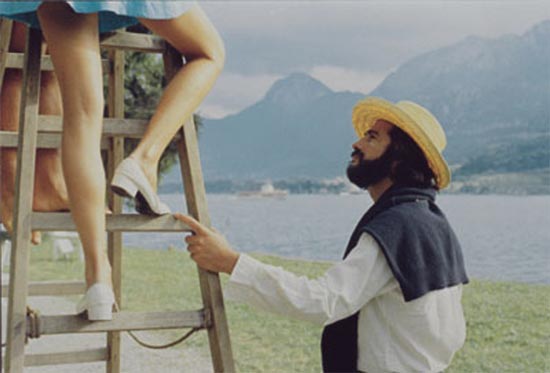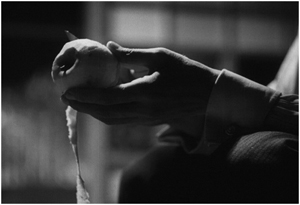FLOWING
1956, Mikio Naruse, JapanRepeat Viewing, DVDFlowing is simply a perfect film. It is an ensemble film centering on the world of woman living in a geisha house (called Tsuta). The film is a parallel of life daily flow and of the crisis of the geisha house. Flowing cuts between several storylines of each woman of the geisha house. The house is rather small and confined which only heightens the flow of everyday life. Men are hardly seen, but there presence is felt in the financial burden of the geisha house (as well as the reality that the geisha house is survived to serve men (but Flowing is certainly not a film set on sensationalizing geishas in the way many films do). As is a Naruse trademark money and debt obligations becoming a critical factor. From the opening shot, Flowing becomes a film of the flow of life. Within the troubles of the geisha house lies the films emotional core, which is that of the maid, played by the great Kinuyo Tanaka. She is nicknamed Oharu (reminding viewers of her career defining role in Kenji Mizoguchi’s 1952 masterpiece Life of Oharu), and she represents the everyday daily flow of life in the most endearing and caring manner. Oharu is like the outside observer of this world, as Flowing may above all be a film which unites together two different worlds of Japanese women. Each of these women are portrayed with such depth and insight and the powerful ensemble cast of actresses (Isuzu Yamada, Hideko Takamine, Mariko Okada, Haruko Sugimura, Sumiko Kurishima, Chieko Nakakita, Natsuko Kahara) are each outstanding. Of course, Kinuyo Tanaka is standout as the maid, but she is far from alone. There is such complexity in the narrative, the emotions, the performances, and Naruse’s mise-en-scene. However, despite all the complexities and depths at hand, Flowing remains definitive of Naruse in the simplistically formal style. As the title suggest Flowing is a film that flows between characters and between spaces within the geisha house and its environment- as well as the flow the its services and its finances. As the narrative flow moves along, the film intermittently suggest the flow of the passage of time, be it through contemplative moments (the cat, the river, the neighbors in the garden) or through subtle references of passing time (such as the aging process, or advancement of modern technology). Naruse does this all with the most simplistic and masterful stroke, leaving an ambiguous sense not of sadness or inevitability, but of the path, the choices, and the flow of life. The ending is one of the great moments of Japanese cinema. A 7-minute scene of no dialogue that openly leaves the feeling of both the inevitable demise of the geisha house (of even the traditions of the geisha), as well as celebrating the culture and art of the geisha. Naruse flows the sequence by detailing the daughter alone sewing (perhaps preparing a future profession), the maiden teaching the new class of geisha (the future of the house), and the maid fluctuating in-between the two with offerings of a treat (all while being the only one aware of the future). Truly a remarkable and complex moment all done with the touch of simplicity from Naruse, it is a reflection of the entire film and of Naruse as a master. Flowing rates alongside When a Woman Ascends the Stairs as my favorite Naruse film, and it belongs mention among the very greatest ever made.
>>> Here is a scene from Flowing:ARTIFICIAL INTELLIGENCE A.I.
2001, Steven Spielberg, United StatesRepeat Viewing, DVD
In 1982 Stanley Kubrick purchased the rights to Brian Aldiss’s short story Super-Toys Last All Summer Long. After finishing Full Metal Jacket Kubrick began to work on Artificial IntelligenceA.I. as his next film. Kubrick was not satisfied with the initial script he was working on with Bob Shaw and Ian Watson. In 1994, he completed a partial script (with Chris Baker’s drawings) and began on the pre-production. However, Kubrick decided to postpone A.I. in hopes computer technology would improve. In 1995 he then began working on Eyes Wide Shut with A.I. to behis next film. After his death in 1999, Steven Spielberg wrote his own version based on much of Kubrick and Baker’s existing material. This particular film is Spielberg's (as he changed muchof the script- notably with the Gigilo Joe character), but ultimately it is just as much a Stanley Kubrick film. Would it have been better had Kubrick directed it? That question will forever remain unknown, but it's really not that important. However, what is known is the work that has been made, and to me it is a masterpiece collaboration of both Kubrick's and Spielberg's vision (which is surprising considering it deals with Kubrick-esque dark and disturbing examinations of the differences between human and non-human). I personally believe it stands among the very greatest films ever made and both Kubrick and Spielberg deserve equal praise. Though influences are evident, in many ways these two filmmakers have contrasting styles which, when combined, seem to really work within the themes of this film. I think A.I. was a very personal and important film to Kubrick, and he even thought much of it was more suitable for Spielberg. I believe Spielberg was very respectful of Kubrick's idea, and yet he still managed to express his own personal vision into the film. What results if a masterpiece of cinema that will stand the test of time and be recognized among the great achievements of filmmaking. Spielberg handles the subject matter perfectly. From the opening narration (one of many Kubrick homages?), the viewer is presented with a dark and chilling mood of a (artificially) secure futuristic atmosphere. It'san extremely intense and rare film that dares to be bold. We are shown humanity as a minor piece of something greater, life is simply a state of mind. Among other questions, AI asks: What makes the human race the ultimate value of emotions and awareness? If it's humans who create these computer programs and robots to act and react as humans, what determines the difference amongst them? Originally I thought the ending was a sappy cop-out, but have come to nderstand it's brilliance. It's perfect! Sure it's sentimental at it's surface, but yet underneath remains a dark, haunting, sad, and meaningful depth. Like Pinocchio, David has a dream. The dream comes true, but not from the world which created him. The ending also represents technology as humans savior (humans create mechas, now mechas create humans). David is the key to human savior; a mecha that is human. AI is a masterfully crafted, emotionally engaging, visually stunning, and ultimately thought-provoking film experience that will stay in the viewers mind long after watching. It will surely be recognized, discussed, and praised as a classic over time. "
I am. I was."









